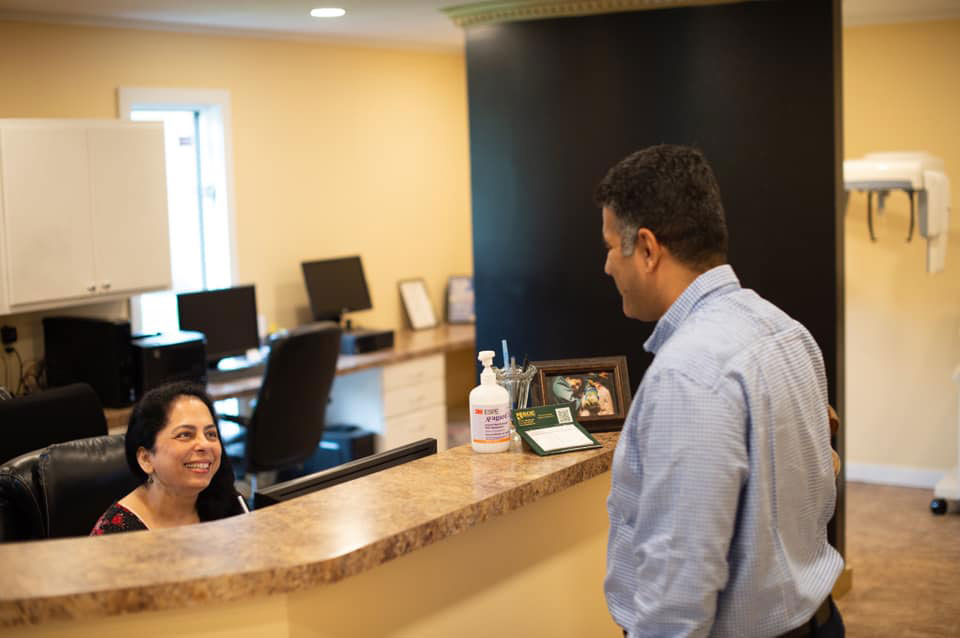
Fixed dental bridges involve the preparation and crowning of teeth on either side of an area missing teeth to support artificial teeth to span the edentulous area.
A fixed bridge is a non-removable appliance fabricated to replace missing teeth, which closely resembles a patient’s natural dentition. Besides serving to restore the appearance and performance of a complete smile, a fixed bridge also prevents teeth that are adjacent to or opposite the edentulous area from shifting to protect the integrity of the occlusion. Fixed bridges are strong, durable and natural looking restorations, which once they are permanently cemented into place allow all manner of normal oral function.
Maintaining a healthy smile depends upon keeping your teeth and gums clean with a daily routine of brushing and flossing. According to the recommendations of the American Dental Association, it is important to brush your teeth at least twice a day for two minutes each time with a soft bristled toothbrush. Remember to use a soft bristled toothbrush and apply gentle pressure so as not to cause damage to your teeth or gums. Brushing your teeth with a fluoride containing toothpaste that has been awarded American Dental Association seal of acceptance helps to keep your smile healthy and vibrant. Remember to change your toothbrush every three months or when the bristles are frayed.
Once commonly referred to as, "porcelain jackets," today's all-ceramic crowns are fabricated from advanced generations of aesthetically appealing, lifelike materials affording strength and durability approaching that of tradition metal and porcelain fused to metal crowns (PFM).
When a tooth requires a full coverage restoration to rebuild its structural integrity and appearance, how good the crown will look and how well it will withstand the forces of oral function are major considerations in choosing the type of crown. In the past, only metal crowns or ones fabricated out of porcelain fused to an underlying substructure of metal offered the strength required to bite and chew without breaking. While porcelain fused to metal crowns to this day remain a popular choice for strong, attractive and long-lasting restorations to rebuild teeth that are damaged, decayed, misshapen, worn down, undersized, or have had a root canal procedure, there are some drawbacks. For one thing, the thin metal margin at the collar of a PFM crown may be visible at the gumline (especially in the presence of receding gums). Also, due to the presence of an underlying metal shell, porcelain fused to metal crowns do not come close to handling light in the same way as natural tooth structure or dental ceramics.
Sometimes it is necessary to extract a tooth. This can happen for a variety of reasons. Extractions are commonly performed in cases where a deciduous "baby" tooth is reluctant to fall out, a severely broken down and non-restorable tooth is present, or "wisdom tooth" is poorly positioned and unable to fully erupt into place.
With advances in dental materials and science, restorative materials that are aesthetically pleasing as well as strong and durable are widely available for the filling and repair of teeth that have been affected by tooth decay or dental injuries.
Composite fillings, which are frequently referred to as either "tooth colored fillings" or "white fillings," are a combination of biocompatible resins and finely ground, glass-like filler materials. Composite fillings, which are manufactured in a complete range of natural looking shades, provide a more cosmetically pleasing alternative to traditional "silver" fillings. Often used to fill a tooth by replacing tooth structure that is missing due to injury or decay, dental composites can also be placed to modify a tooth’s color or shape to dramatically improve its appearance as well as repair dental defects and close gaps between the teeth.
A teeth whitening procedure or bleaching simply refers to any process that will make the teeth appear whiter. It is considered a non-invasive procedure that is designed to whiten and brighten teeth that are stained, discolored, darkened, or yellowed. First introduced to the public in the 1980’s, the popularity of teeth whitening products and procedures has soared. According to a survey conducted by the American Academy of Cosmetic Dentistry, when respondents were asked, "What would you like to improve most about your smile?" The most common response was: whiter and brighter teeth.
A home whitening system from the dentist along with custom trays that have been fitted to the teeth is also an excellent option. Custom trays keep the bleaching agent in maximum contact with the teeth and away from the other areas of the mouth. With a take-home teeth whitening system, maximum results are less rapid than an in office procedure and are typically achieved over a longer period of time. A home whitening system can be used by itself or as recommended by the dentist as a follow up to an in office procedure in order to perfect or maintain the results.
Dental implants represent the most recent and advanced method of replacing lost or missing teeth. Invented in 1952 by a Swedish surgeon named Per-Ingvar Brånemark, dental implants today offer a highly effective, long-term solution for replacing missing teeth to reestablish a fully functional and attractive smile. Dental implants can be used to replace a single tooth, multiple teeth or all of the upper and/or lower teeth.
A dental implant is a small, biocompatible post that is surgically positioned by means of a minimally invasive procedure into the jawbone beneath the gums. Once healing takes place and the implant integrates with the bone, it behaves in much the same way as the root of a natural tooth to provide support for an aesthetically appealing dental crown or bridge. A period ranging from 3 to 6 months is required for the jawbone to fuse with the implant via a process known as osseointegration.
Periodontal disease damages the surrounding soft tissues and bone that support the teeth. It is predominantly caused by the accumulation of bacteria, mucus and other particles in the form of plaque or tartar that sit between the teeth and the gums. Periodontal disease can range in severity from a simple gum inflammation, known as gingivitis, to a more serious inflammation of the periodontal tissues. Left untreated periodontal disease can result in significant tissue damage and eventual tooth loss.
For teeth with imperfections that cannot be addressed with teeth whitening procedures, but are not so flawed as to require full coverage crowns, dental veneers can provide the desired cosmetic improvements.
Dental veneers are custom-fabricated facings that offer a conservative and cosmetically pleasing way to improve the appearance of teeth that are chipped, gapped, worn, slightly crooked, misshapen or darkly stained. With dental veneers, the color, shape, size, and length of the teeth can be changed for the better. Bonded to the front surfaces of the teeth, veneers can be used to enhance the appearance of a single tooth or multiple anterior teeth.
Wisdom teeth, which are also known as the third molars, are the last permanent teeth to develop in the oral cavity as well as the final ones to come into place. However, as is often the case, many wisdom teeth do not have sufficient room to erupt, are not developing properly, or are causing issues for the adjacent teeth and the surrounding tissues. Oral and maxillofacial surgeons frequently see patients with impacted or problematic wisdom teeth for an evaluation or extractions as indicated.

We believe everyone deserves a healthy, beautiful smile that boosts their confidence and overall well-being.
Whether you require routine preventive care, advanced restorative treatments, or cosmetic dentistry to achieve your dream smile, we offer a comprehensive range of services to cater to your unique needs. We believe in open communication and will work collaboratively with you to develop a personalized treatment plan designed to achieve your optimal oral health goals.